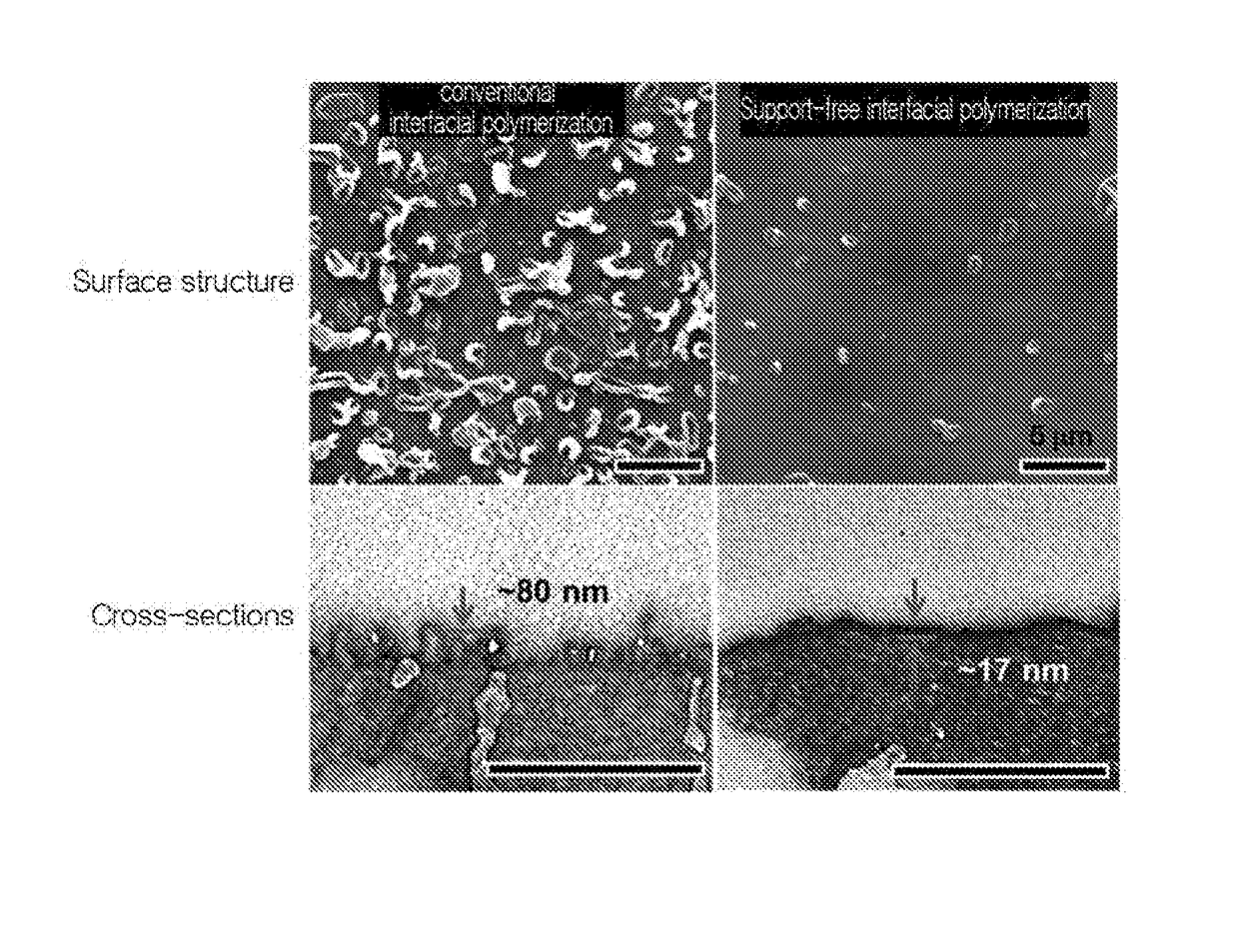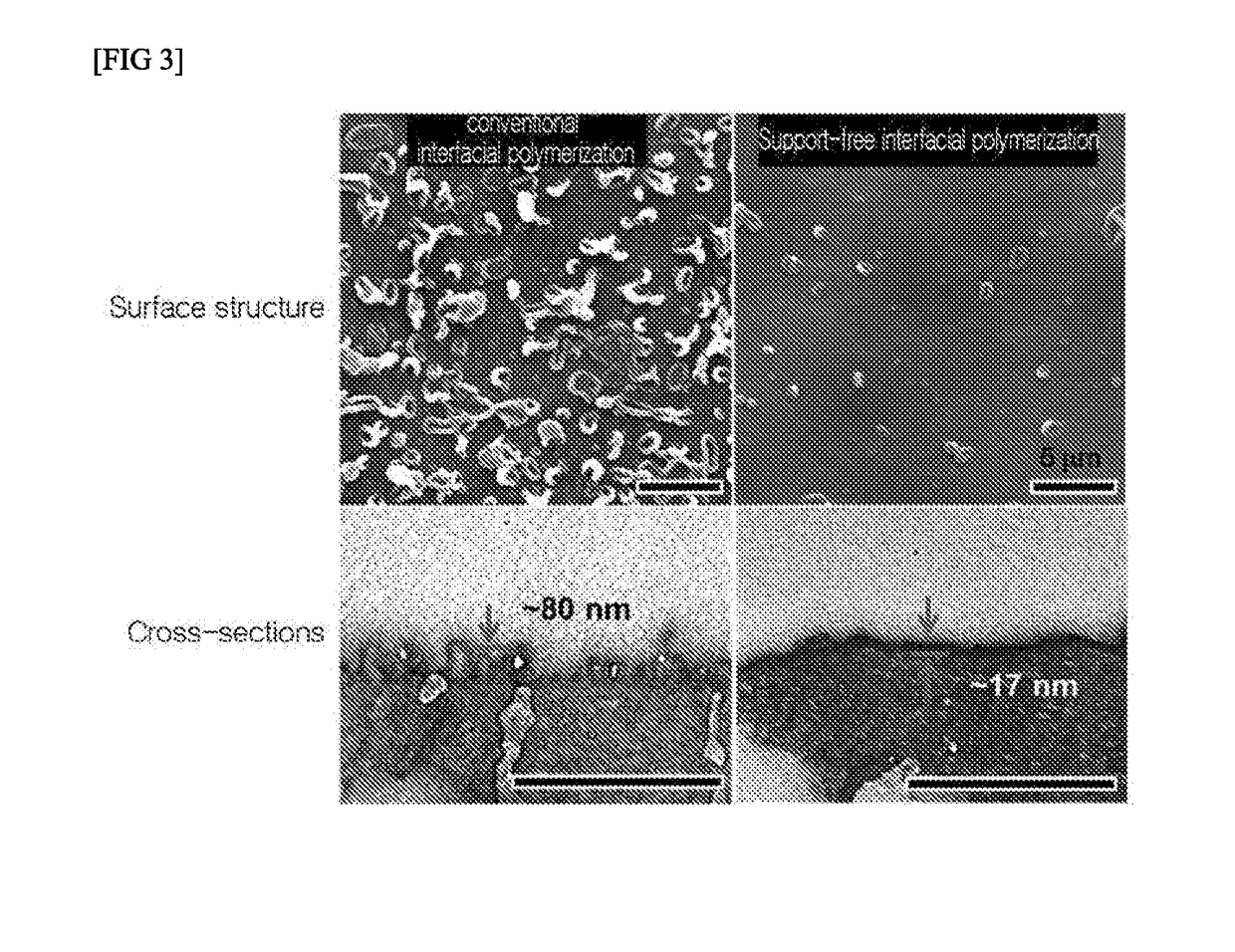Method for manufacturing membrane using selective layer prepared through support-free interfacial polymerization
a technology of interfacial polymerization and selective layer, which is applied in the field of manufacturing a selective layer, can solve the problems of poor chemical durability, low removal performance, and limitation in expanding the product specification and application field of a reverse osmotic membran
- Summary
- Abstract
- Description
- Claims
- Application Information
AI Technical Summary
Benefits of technology
Problems solved by technology
Method used
Image
Examples
example 1
re of Composite Membrane Having Selective Layer Formed Through Interfacial Polymerization at Free Interface which does not have Support (Support-Free Interfacial Polymerization)
[0033]Material
[0034]Porous support: a polyacrylonitrile (PAN) support having a pore size of about 20 nm was hydrolyzed in a NaOH aqueous solution to modify a surface thereof.
[0035]Organic monomer and solvent for interfacial polymerization: m-phenylene diamine (MPD) was used as a first organic monomer and dissolved in water, a first solvent. Trimesoyl chloride (TMC) was used as a second organic monomer and dissolved in hexane (n-hexane), a second solvent.
[0036]Manufacturing Method
[0037]A selected porous PAN support was fixed in a container equipped with a valve.
[0038]A first solution (MPD aqueous solution) was poured onto the PAN support fixed in the container such that the support was completely submerged.
[0039]A second solution (TMC organic solution) prepared of an organic solvent which is immiscible with th...
example 2
ion of Performance of Manufactured Membrane
[0046]In order to verify the performance of the composite membrane manufactured using a PAN support by the method for Example 1, a 2000 ppm NaCl aqueous solution was permeated through the following (1) or (2) membrane under a high pressure (15.5 bar) condition to determine water flux and a salt rejection rate, by which membrane performance was compared.
[0047]A conventional interfacial polymerization-based membrane (manufactured by the methods disclosed in U.S. Pat. No. 4,277,344 and U.S. Pat. No. 5,614,099)
[0048]A support-free interfacial polymerization-based membrane (manufactured by the support-free interfacial polymerization according to the present invention)
[0049]As a result, as shown in Table 1, it was confirmed that the performance of the membrane significantly varies depending on the two manufacturing methods. That is, while the membrane manufactured through the conventional interfacial polymerization exhibited a salt (NaCl) rejecti...
PUM
| Property | Measurement | Unit |
|---|---|---|
| Pore size | aaaaa | aaaaa |
| Pore size | aaaaa | aaaaa |
| Thickness | aaaaa | aaaaa |
Abstract
Description
Claims
Application Information
 Login to View More
Login to View More - R&D
- Intellectual Property
- Life Sciences
- Materials
- Tech Scout
- Unparalleled Data Quality
- Higher Quality Content
- 60% Fewer Hallucinations
Browse by: Latest US Patents, China's latest patents, Technical Efficacy Thesaurus, Application Domain, Technology Topic, Popular Technical Reports.
© 2025 PatSnap. All rights reserved.Legal|Privacy policy|Modern Slavery Act Transparency Statement|Sitemap|About US| Contact US: help@patsnap.com



